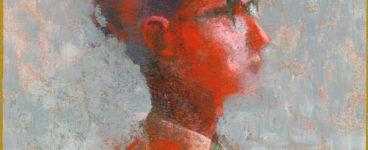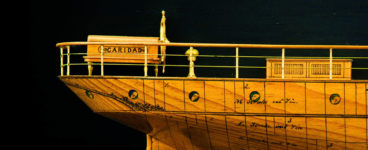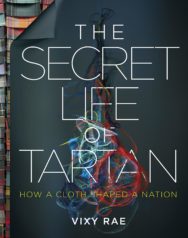‘It is the Fabric of the Nation.’
The Secret Life of Tartan is a gorgeous and fascinating book on our nation’s cloth, ideal for the fashionista or history buff in your life. Within its pages, Vixy Rae speaks to many people involved in the tartan industry, and in this extract she speaks to Peter Macdonald, a tartan historian.
Extract taken from The Secret Life of Tartan: How a Cloth Shaped a Nation
By Vixy Rae
Published by Black and White Publishing
Peter MacDonald is a man who quite possibly has forgotten more than I will ever begin to know about tartan. Peter is Scotland’s foremost tartan historian; his main area of interest is the Jacobite era and the early commercial production of tartan. And so, in my quest to weave together the whole historical pattern that is tartan, I turned to him as surely the world’s leading authority on its history and its design. I posed a few questions to help ease myself into this new, intricate world of structure and colour, hoping to broaden my knowledge by absorbing some of his. I came away from our meeting convinced that if you were to cut him in half, he would be tartan all the way through – like a stick of rock, only more stylish.
Vixy Rae: How would you define tartan? What is its defining quality?
Peter MacDonald: Historically, the term tartan was used to describe a type of cloth, irrespective of pattern. More commonly, it describes the multi-coloured, cross-barred pattern woven from solid coloured yarns, which distinguishes it from tweed. As a design, tartan is not unique to Scotland but only here did it develop the cultural significance that is inextricably linked to the Highland clans and which later became perhaps the unifying symbol of Scottishness. It is the Fabric of the Nation.
For you, which tartan represents the pinnacle of design in colour and complexity of sett?
There are a number of contenders for the title but perhaps the finest example is the tartan designed in 1713 for the Royal Company of Archers’ first uniform. The tartan was replaced by the Black Watch tartan in the late 18th century but not before it had been used as the basis for Ogilvie and Drummond of Strathallan tartans.
And which is your least favourite?
I’m not a fan of a lot of modern fashion tartans, principally because they often use colours and colour combinations that are non-traditional; for example: pink, yellow, purple and light blue, which I just don’t find pleasing. I also find the current trend for dull and bland colours, such as those of the Outlander range of tartan, visually unsatisfying and historically misleading. In the 18th century, red was the colour of choice for those that could afford it, the gentry were invariably painted in red-based tartans and the majority of surviving specimens reflect this.
What is the earliest surviving garment made from the cloth?
The nature of our climate and soils, together with the need to reuse garments and cloth in the past, means that few old examples of tartan survive. We have nothing that was created before the mid-18th century and only a number of examples associated with the Jacobites.
When was tartan’s defining moment? When did it become noteworthy in historical terms?
If there’s one date that is significant above all others it is 1822, the date of Sir Walter Scott’s Royal Pageant and the tartan jamboree associated with George IV’s visit to Scotland.
There appears to be a revival in the wearing of trews. Do you think this takes away from the Scottishness of tartan use?
No, why should it? Trews (triubhas) have been part of Highland dress since at least the 17th century, long before the development of the modern kilt.
When Sir Walter Scott was planning the Royal Pageant, many clan chieftains apparently had no idea what their tartan was. Or is this a myth?
In 1815 the Highland Society of London set about collecting ‘traditional clan tartans’ in order to preserve them. They wrote to the clan chiefs asking them to submit a specimen of their clan tartan. The trouble was that the idea that there had been such a thing as clan tartans was a recent invention.
The Society’s correspondence reveals that most of the chiefs had no idea what their ‘true clan’ tartan was. The chief of MacPherson supplied a tartan that only a few years before had been a Wilsons’ fancy pattern which they called No.43, Kidd or Caledonia. So many chiefs submitted a piece of Government (Black Watch) tartan, probably because they’d served in the army, that the Society’s officers had to restrict the number that they would accept.
The world is becoming a global village. Is it important for tartan to be celebrated and held in high esteem around the world?
For me, it’s more important to preserve an understanding of the historical use and traditions of tartans for future generations. I was fortunate to have met and learned from some of the significant tartan researchers of the past – now there’s just me. Where is the next generation and how do we collate and preserve our history? The work of the Scottish Tartans Authority is important in helping to preserve knowledge but there’s always more to do.
What is the most obscure tartan that you know of?
Goodness, where to start? The Scottish Tartans Authority has over 9,000 tartans on its database; fewer than one hundred pre-date 1800, so my answer would have to be one of the early 18th century cloths.
Undoubtedly the most obscure tartan, in terms of rarity and uniqueness, is that from the only known surviving coat of the Ancient Caledonian Society (ACS). The coat, which is in the collection of the Scottish Tartans Authority, dates to c1786 when the ACS was formed. The previously unknown tartan was almost certainly designed for the Society and is unusual in having a decorative silk motif woven into it. On each of the red squares there is a white rose and two buds representing King James VIII/III and the Princes Charles and Henry. The use of such obvious Jacobite iconography only thirty-three years after the last execution of a Jacobite leader is extraordinary and shows just how safe it had become to make such references without fear of reprisal. Tartan, with a secondary design such as the rose motif, would have been woven on an early Jacquard-type loom, probably outside of Scotland, possibly in Norwich which was famous for this type of weaving.
Do you have a favourite, little known story about the cloth you could share?
I wove the material for Prince William and Prince Harry’s first kilts. The tartan was the Prince Charles Edward, an early variation of the Royal Stewart tartan, which is said to have been worn as ribbons on the wedding coat of Charles II.
Thirty-odd years later, I was privileged to work on a version of the Prince Charles Edward Stewart tartan that the Scottish Tartans Authority gifted to HRH Prince Charles; a tartan which he often wears when in Scotland.
The Secret Life of Tartan: How a Cloth Shaped a Nation by Vixy Rae is published by Black and White Publishing, priced £25.00
ALSO IN THIS ISSUE

 Blessed Assurance
Blessed Assurance
‘An at that moment a muckle great waw cam crashin oan tae the rocks an the waater hit against the pr …

 Ship Models
Ship Models
‘Their dexterity and creativity as individuals is inspiring, and collectively they have left an exce …













